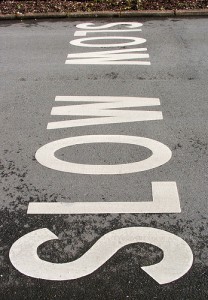Slow. Slooow. Slooooooooooow. Like a snail moving-in-molasses-on-a-cold-day slow. It’s painful. Especially to those who are accustomed to quick movements, stealth flow, and instant responses. It’s almost unbearable. And, yes, for some, it’s definitively unbearable and they must move on to save themselves. Adapt or die. This is true for the brain, as well.
I get that. I understand it. I know the feeling. I like strategic, quick moves and results. I enjoy bouncing from completed initiative to completed initiative. I really love seeing a strategic plan for a project in retrospect, and I’m one of those people that tend to push others to accomplish what seem like unrealistic deadlines and goals within tenuous timeframes. Funny thing – people end up reaching those deadlines and goals and astounding themselves…but I digress…
There are times when stealth just won’t cut it. The “yesterday” deadline is [yawn] over-rated, and the only way success is measured is inch-by-oh-my-save-me-this-is-painful-inch and moment-by-Really?–I-feel-like-I’ve-been-at-this-forever-moment. On more than one occasion in my career, I have had to readjust my pace for the health and well-being of my team. Sometimes I slowed down, and other times my team acknowledged it was ready to pick up the pace. In all matters, the organization, the programs, the quality of patient care propelled forward. Fast or slow. Why?
Because progress is progress. While it can be mentally strenuous for leaders, sometimes slow and steady is necessary and ends up leap-frogging others who traveled at break-neck speed. “Haste makes waste,” anyone?
Have you ever lived this lesson?






